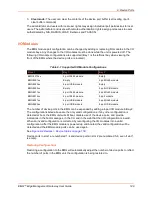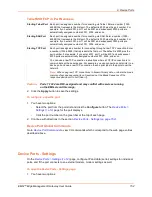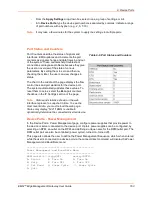
9: Device Ports
EMG™ Edge Management Gateway User Guide
159
Hardware Signal Triggers
Note:
When the DSR signal drops on a device port, indicating that the attached cable has been
disconnected or the attached device has been powered off, the EMG will log the event in the Device
Ports system log and send a slcEventDevicePortAction SNMP trap. The log message and SNMP
trap only occur if there is an active (connect direct or network connection) to the device port.
Parity
Parity checking is a rudimentary method of detecting simple, single-bit errors.
From the drop-down list, select the parity. The default is
none
.
Flow Control
A method of preventing buffer overflow and loss of data. The available methods
include
none
,
xon/xoff
(software), and
rts/cts
(hardware). The default is
none
.
Enable Logins
For serial devices connected to the device port, displays a login prompt and
authenticates users. Successfully authenticated users are logged into the
command line interface.
The default is disabled. This is the correct setting if the device port is the endpoint
for a network connection.
Max Direct Connects
Enter the maximum number (1-15) of simultaneous connections for the device
port. The default is 1.
Show Lines on
Connecting
If enabled, when the user either does a
connect direct
from the CLI or
connects directly to the port using Telnet or SSH, the EMG outputs up to 24 lines
of buffered data as soon as the serial port is connected.
For example, an EMG user issues a
connect direct device 1
command
to connect port 1 to a Linux server.
For example, if the user issues the
ls
command to display a directory on a Linux
server, then exits the connection, the results of the
ls
will be stored in the buffer.
When the user then issues another
direct connect device 1
, the last 24
lines of the
ls
command is displayed so the user can see what state the server
was left in.
USB Channel
Applies to USB device ports only. When a dual channel USB device is connected
to the device port, this allows the user to select which of the channels is the active
channel used for all connections. Only one channel can be active at any time.
Enter the number
1
or
2
. The default is
1
.
Check DSR on
Connect
If this setting is enabled, the device port only establishes a connection if DSR
(Data Set Ready) is in an asserted state. DSR should already be in an asserted
state, not transitioning to, when a connection attempt is made. Disabled by default
unless dial-in, dial-out, or dial-back is enabled for the device port.
Note:
Applies to serial RJ45 device ports only.
Disconnect on DSR
If a connection to a device port is currently in session, and the DSR signal
transitions to a de-asserted state, the connection disconnects immediately.
Disabled is the default unless dial-in, dial-out, or dial-back is enabled for the device
port.
Note:
Applies to serial RJ45 device ports only.
Assert DTR
By default, DTR (Data Terminal Ready) is asserted on a device port nearly all of
the time (except momentarily when a port is opened for operations). Unchecking
this option will deassert DTR, simulating a cable disconnection for the device that
is connected to a device port.
Note:
Applies to serial RJ45 device ports only.
Содержание EMG 8500
Страница 1: ...Part Number PMD 00008 Revision A October 2019 EMG Edge Management Gateway User Guide EMG 8500 ...
Страница 69: ...6 Networking EMG Edge Management Gateway User Guide 69 Figure 6 2 Network Network Settings 2 of 2 ...
Страница 302: ...14 Maintenance EMG Edge Management Gateway User Guide 302 Figure 14 12 About EMG ...
















































